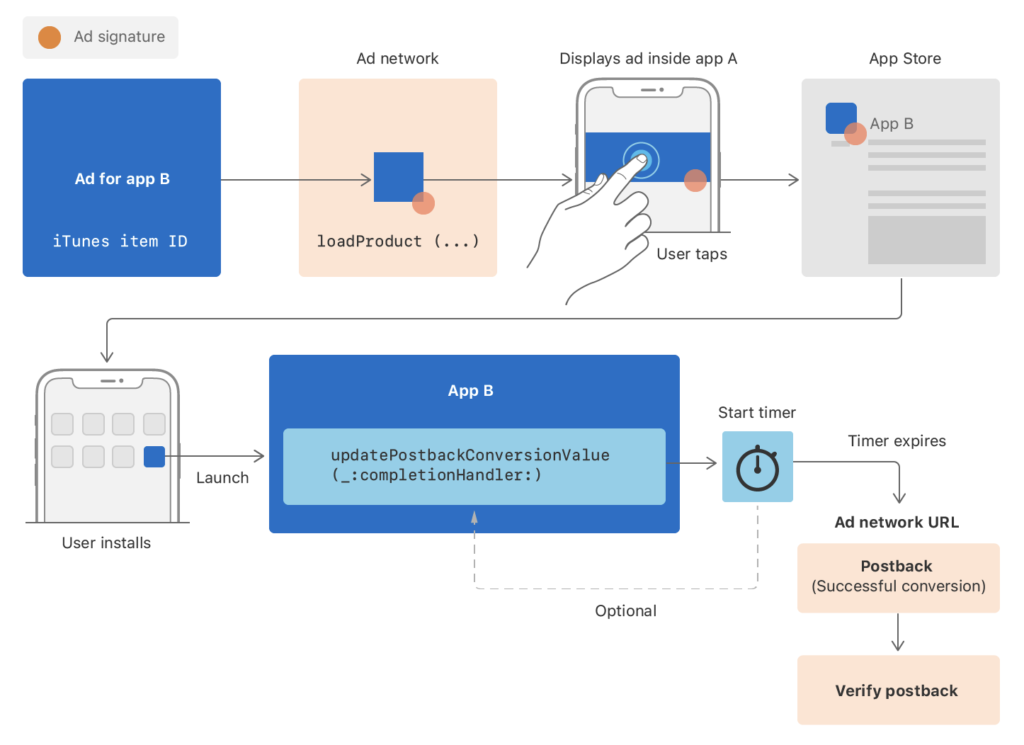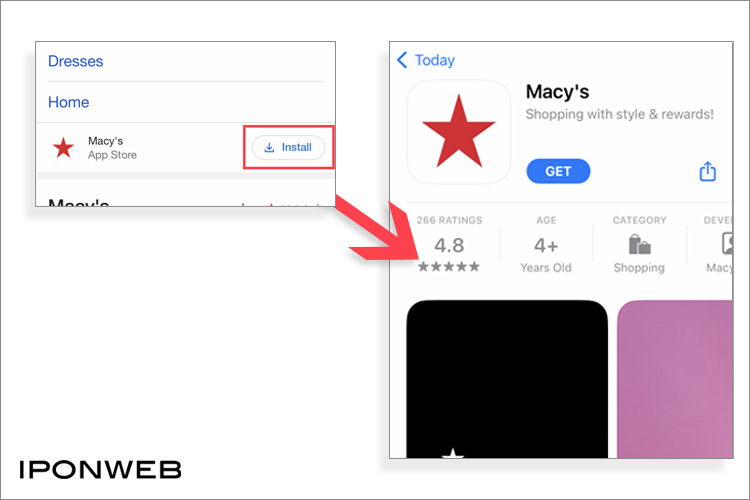In 2018, alongside iOS 14, Apple introduced two new privacy-focused technologies. The AppTrackingTransparency (ATT) framework required users to consent to tracking, whereas SKAdNetwork served as an attribution safety net for those that didn’t. Here’s what marketers need to know about SKAdNetwork in 2022 and beyond.
Table of Contents
- What is SKAdNetwork?
- How SKAdNetwork works
- StoreKit-Rendered Ads and View-Through Ads
- The limitations of SKAdNetwork
- What does SKAdNetwork mean for marketers?
- The future of SKAdNetwork
What is SKAdNetwork?
SKAdNetwork (or StoreKit Ad Network) is a privacy-first framework launched by Apple in 2018 to enable advertisers to track the effectiveness of their User Acquisition (UA) campaigns in aggregate, without visibility of user-level data.
SKAdNetwork was created alongside another privacy-focused initiative, Apple’s AppTrackingTransparency (ATT) framework. If you’ve used an iPhone in the last few years, you’ve probably seen the consent pop-up asking if you’re happy for your activity to be tracked. This is an opt-in for IDFA (Apple’s unique device ID) sharing, and stats suggest that adoption remains low, with only around 20% of users accepting tracking as of September 2021.
So how do advertisers continue to measure the effectiveness of their UA campaigns without access to IDFA user-level tracking? This is where SKAdNetwork – Apple’s campaign tracking safety net – comes into play.
How SKAdNetwork works
To maintain user privacy, SKAdNetwork is designed to prevent data being traced back to any single individual. It does this via the aggregation of conversion event data combined with a time delay in reporting.
SKAdNetwork relies on three core components:
- An app’s Ad Network, which signs the ad and is responsible for receiving confirmation should the ad lead to an install.
- The source app, where the ad itself is actually displayed.
- The advertised app, which is the app being promoted by the ad.
To simplify how conversions are attributed in the SKAdNetwork framework, here’s a play-by-play of an ad impression leading to an app install conversion event:
- An ad for app 1, which has been signed by an ad network, appears in app 2. The signature of the ad includes an encrypted value for the campaign ID, which is required for attribution.
- A user taps the ad within app 2 and is taken to the App Store to install it.
- Once installed, an install attribution “postback” is sent to the ad network between 24 and 48 hours later. A postback is essentially a notification sent to an ad network when a specific event – like an app install or in-app action – occurs. Conversion values, which can be used to represent specific actions within an installed app, can optionally be sent alongside the attribution postback.
- The ad network receives the winning postback and can share the data with its advertisers. Following iOS 14.6, up to five ad networks can also receive non-winning postbacks. And, starting from iOS 15, developers of advertised apps can also opt-in to get copies of the winning postbacks for reference.
 Source: https://developer.apple.com/documentation/storekit/skadnetwork
Source: https://developer.apple.com/documentation/storekit/skadnetwork
StoreKit-Rendered Ads and View-Through Ads
It’s worth mentioning the two types of ads available via SKAdNetwork: StoreKit-Rendered and View-Through Ads.
At launch, the only ad type available was StoreKit-Rendered, which is essentially a rendering of an app’s App Store page alongside an install button to allow users to install directly without having to visit the App Store itself. Once a user clicks the install button, StoreKit presents an overlay of the advertised app’s product page. For a StoreKit-Rendered ad to qualify for an install-validation postback, the user must install the app within 30 days.
 A StoreKit-Rendered ad in action
A StoreKit-Rendered ad in action
With the 2.2 update of SKAdNetwork, Apple also introduced support for View-Through Ads, which can essentially be any type of ad placement – display, video, etc. – served by any supported third-party ad server. For View-Through Ads to qualify for an install-validation postback, the user must install the app within 24 hours.
The limitations of SKAdNetwork
As changes such as the introduction of View-Through Ads demonstrate, Apple is open to making changes to the SKAdNetwork framework to help marketers get more from their advertising dollars.
That said, there are still plenty of limitations for this framework when compared to IDFA-driven tracking.
- To ensure user-level data is further obscured, there is an enforced postback delay of between 24 and 48 hours.
- Only 100 campaigns per ad network per-app are supported.
- Apple only sends data in aggregate, making smaller scale campaigns more difficult.
- For advertisers, aggregated data is only sent to the ad network, meaning it has to be collected from each one they work with. This also necessitates a level of trust in the ad network’s reporting.
- For publishers, integrating with the SKAdNetwork API is essentially a requirement in a post-IDFA world. Relying on IDFA opt-in rates is likely to be a losing game in the long-run.
What does SKAdNetwork mean for marketers?
For advertisers, SKAdNetwork has become the de facto method for conversion tracking and attribution for CPI and UA campaigns on iOS.
While not a perfect solution, especially compared to IDFA tracking, it’s currently the only option to achieve any level of scale in reporting. In addition, with 81% of large app publishers either already using SKAdNetwork or planning to in the near future, the industry’s direction of travel seems clear. And where publishers go, advertisers are sure to follow.
The future of SKAdNetwork
With multiple iterations – including some significant changes and improvements – of SKAdNetwork already released, the next big leap is already in motion.
The release of SKAdNetwork 4.0 in late 2022 saw Apple making changes to conversion windows, conversion values, and web-to-app tracking for Safari. To learn more about SKAdNetwork 4.0, check out our Q&A with Ionut Ciobotaru of Verve Group.






